Kids’ Toolbox Series #1: 25+ Coping Practices for Kids by The Sassi-Vannier’s
[Disclaimer: My son, daughter and I each took turns writing the actual list above and we all contributed to the this list, including my husband Pierre Etienne Vannier the mind/body practitioner. The kids also reviewed, edited and approved this blog before publishing. Writing this together was a fun and helpful family bonding exercise and we encourage you to do the same with your loved ones. Stay tuned for part 2 of this for our Kids Toolkbox Series as we continue to update our list! ]
“I can’t” said my daughter after her 3rd meltdown that day and when I asked her to utilize one of the coping practices she’s already learned and knows. My daughter has real big emotions. We all do, I know. And I’m sure most of us have trouble bringing ourselves back to our centers when in the thick of our big feelings. She’s not the only one that feels the overwhelm of “I can’t!” We’ve likely all been there and I am grateful for my daughter for so clearly articulating exactly what was going on with her. Children are amazing like that, they have an ability to speak honestly and directly– it us adults that add story, analysis and interpretation to their experiences. “This was not the only time I said ‘I can’t,'” she just reminded me as she was reviewing this blog. “I always say ‘I can’t!’ mama.” Some deep listening, or perhaps just simple listening without our adult filters, and we’ll find that kids are often giving us a very clear diagnosis of what is going with them. So thank you kids for telling us like it is!
My daughter has a tendency to express her emotions in a really big way, whereas my son is more likely to keep his emotions inside, rarely expressing his feelings. I think most people would agree that expressing one’s emotions is always better than bottling them up; but expressing them doesn’t necessarily mean healthy processing either. There is healthy expression and not so healthy expressions, sometimes resulting in relationship fallout. Often our expressions are more uncontrollable reactions or subconscious patterns, especially when we are adults. And I do not want temper tantrums to be my daughter’s adult pattern or her only way of coping when feeling overwhelmed. I don’t want that to be my go to either, working on it. Both her and I have fire energy and are quite explosive– but explosions can be messy and are felt by everybody and that’s not helpful for anyone.
Regardless of our age, when in the throes of an emotional escalation it is very difficult to source help and support and put into practice useful and safe coping exercises. This realization came to me after my daughter claimed several times “I can’t” when asked to recall and use previously learned coping exercises while in the midst of one of her (daily, sometimes multiple daily) emotional crises. It finally occurred to me that she’s absolutely right, sometimes we just “we can’t.”
Sometimes when overwhelmed with difficult emotions, no matter how much we try– we can’t seem to remember or implement a breathing or centering exercise we learned before. It is a mental check out from our executive function, which is totally normal when in flight, fight or freeze. Our family’s collective inability to find resources for self-coping during an emotional crisis prompted us to write this refrigerator list of coping practices as a family so we can refer to it in moments of need or when in crisis mode. Here is our list explained…
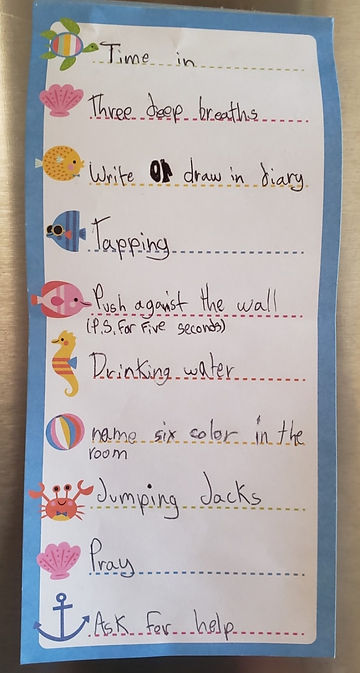
Page 1: Written by my 11 year old son.
1. Time in— This means instead of taking the notorious punishing “time out”, we take some “time in” to check in with ourselves. We remove our-selves from whatever may be triggering the emotional upset and check in with what we may need to feel better? We ask, “Am I hungry? Am I tired? What do I need right now?”
2. Three deep breaths– Before reacting or responding to someone or something we take in 3 long deep breaths. This helps to bring the nervous system out of fight or flight mode.
3. Write or draw in our diary— Before reacting or responding, we take a moment to organize our thoughts and feelings by putting them down in a safe private place. The process of writing alone does wonders for emotional processing, in fact journaling is a main pillar in many healing modalities. Also, it can get extremely exhausting for other members of the family to constantly need to process another member’s explosions. We don’t want to stop my daughter’s expression but we also don’t want her to get in the habit of projecting her difficulties onto others and relying on others to validate or process her feelings. A diary means she can express herself freely without judgment or projection of others.
This can be helpful for both types of personalities, the outwardly expressive type who needs time to diffuse before self-expression and the type who tends to suppress emotions and would benefit from more immediate self-expression as a way to get in touch with their emotions. Writing is a safe healthy medium for expression for most people and processing types as it also incorporates several faculties at once, including somatic processing by using the fingers and hands.
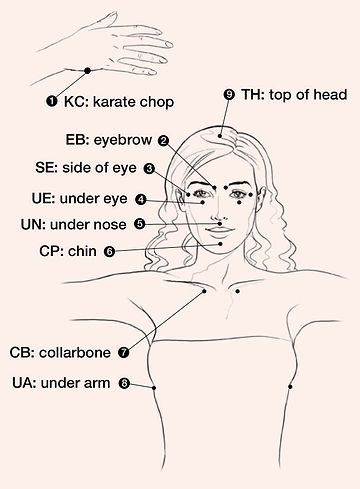
Tapping/EFT Meridian Points and Order
4. Tapping/EFT: This is so quick, so easy, can be done anywhere and helps to transmute emotions in the moment. It consists of tapping the Chinese Medicine Meridians points shown in this photo while saying reframing statements at each point. Here are some good examples of reframing statements. “Even though I feel angry, I have peace within me.” “Even though I don’t feel seen or heard, God and the universe see, hear and accept me.” “Even though I don’t feel loved, God loves me.” I taught this to my kids and will put a pic of the pressure points in their backpacks and fridge (as soon as I get new printer ink) so they can’t have access to this excellent tool anytime!
5. Push against the wall for 5 seconds: this allows for tension in the body to be released neutralizing the nervous system and bringing one back down from an escalation.
6. Drinking water: Believe it or not, dehydration alone is often the main culprit in many emotional escalations, especially ones involving fear or anxiety. As a mineral maniac, I write a lot about the importance of mineral and nutritional balancing for maintaining emotional health and well being. But to put it simply, if you’re basic electrolytes are low due to dehydration– your adrenal glands go into stress mode, releasing cortisol and adrenaline and THAT is just a recipe for emotional and physiological disasters. [Children can also benefit greatly from an HTMA + Targeted Functional Nutrition Plan].
Drinking water also helps to neutralize fire energy which is associated with anger and angry outbursts. Just the act of drinking a glass of water can be so soothing, comforting and relieving in a moment when fire is raging inside.
7. Name 6 colors in the room: this is a mindfulness practice and helps to empty one’s mind of negative thoughts or mental loops by bringing your awareness back to “now”.
8. Jumping Jacks— jumping jacks or any physical movement can help to move pent up or overwhelming energy out of the body. The body is where we process emotions, so it needs our support. Movement also helps to clear the head and bring one back into the body and in the present moment. When my son has trouble sleeping he does push-ups until he falls asleep, LOL.
9. Pray: sing or repeat any prayer that brings peace to your heart and mind and makes you feel closer to Source.
10. Ask for help: Kids need to know two things, they have a right to ask for help and support and if they want help they need to ask for it. People can’t read minds. I tell my kids, “your teacher, friends, siblings don’t know what you need or how you feel.” We have to say what we need and be as direct and clear as possible.
Also, it is metaphysically accepted across all spiritual traditions that guides, guardians and spiritual helpers like angels are always available to help us but that metaphysical law requires that we ask for the help. So I tell my kids, your guides, angels and ancestors are on standby just waiting for you to ask them for help, ask anytime and all the time.
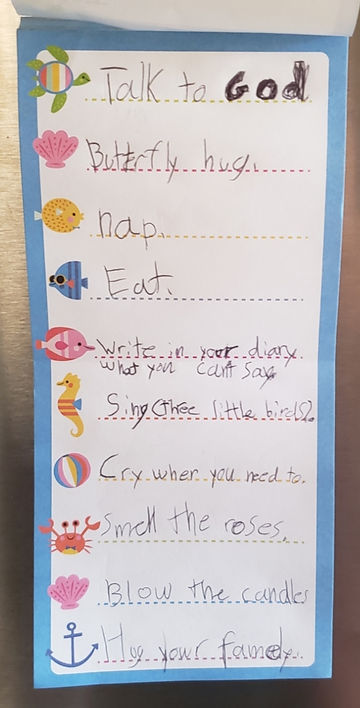
Page 2: written by my 9 year old daughter.
11. Talk to God: I tell my kids to follow their heart on this and to just let it out, “Go tell God all about it. Complain as much as you want.” After meltdown number 4 or 5 and I’m now too overwhelmed with my daughter’s emotions, I tell her that “God is always listening and wants you to turn to him and cry to him for awhile. Go tell everything your heart is feeling to God, He wants to Listen to you.” And she does it. Phew for me, God to the rescue always alhamdulillah!
12. Butterfly Hug: Also an instant “bring me down” that utilizes Chinese meridian points of the chest by hugging yourself by making a butterfly shape hugged with your hands across the chest and tapping the points as the butterfly flaps its wings. See photo below.
13. Nap: My daughter loses it when she’s tired. I lose it when I’m tired. We all lose it, when we’re tired. Once kids outgrow their daily naps, they can start taking power naps like adults do. [I take the occasional power nap when I have time. I think midday rests and naps are so important to our health and productivity, that it would do our whole society a whole lot of good to implement naptime at schools and the workplace. Imagine how much happier and more productive we’d all be if we got to lie down for 20 minutes after lunch for a power nap?]

#12. Butterfly Hug: Flap the hands (butterfly wings) to tap the chest meridians
14. Write in your diary what you can’t say: This is similar to #3 and #9, so I’ll spare the redundancy.
15. Sing a Lullaby or Favorite Song: Three Little Birds by Bob Marley has been my daughter’s lullaby since she was in utero. And both my kids also sing or listen to “Gabriel” by Lamb when seeking comfort.
16. Cry when you need to: Some of us in this family have trouble crying in front of others, I’m not going to name who. So we are trying to de-stigmatize the idea of crying a bit. But we also have my daughter who is a big crier and has a really hard time bringing herself back from hysterical crying, so that’s why #3 and #11 came before this one. 🙂
17. Smell the Roses/Blow the Candles: These are listed on 2 separate lines but are one breathing practice of inhaling like you’re smelling the roses and exhaling like you’re blowing out candles. This practice my kids learned at school, cool huh?!
18. Hug your family. Hugs are lovely and loving safe touch can be so healing and supportive when feeling icky.
19. Give Thanks: My daughter can go into one of those spin outs of self pity, sometimes over something like a paper cut from 5 days ago. I’m not joking! So this is a reminder to count blessings and remember all that is wonderful, great and perfect in our life. Gratitude is essential for maintaining mental health and can instantaneously raise one’s emotional vibration from negative emotions like sadness, anger and fear to feelings of courage, neutrality, willingness or joy. I tell my kids to say thank you to God for specific things like my family, my home, my safety, so they are in a sense counting blessings.
Making mental lists of things we love like rainbows, the beach, unicorns, friends, the blue sky, the warm sun. This is a way of giving thanks but also of engaging in a self guided visualization, which has powerful effects on one’s emotions.
20. Get Busy: Sometimes we have to force it but we just have to disengage from whatever it is we’re in and get busy doing something totally unrelated. Sometimes distractions help.
21. Do Dhikr: Dhikr means remembrance in Arabic and one of our practices of remembrance in our spiritual tradition involves the invocation of a Divine Attribute through sound (chanting) in order to bring us into the Presence of that Attribute. This is a bit complicated of a description but for the sake of simplification it is a practice of remembering our Center and our Source through chanting. Sacred Sound has been used for centuries and across most traditions for healing and alchemizing the mind, body and soul. A well known chant for harmonizing the body from the yoga tradition is the chant of the sound/word “Om”.
22. Yoga: Speaking of yoga, do yoga. Or some kind of movement, see #8. My daughter especially loves yoga and does the amazing and free Cosmic Kids Yoga on youtube.
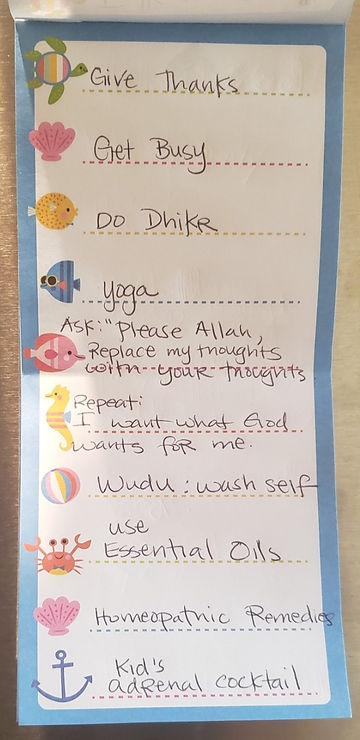
Page 3: written by me.
23. Ask “Please God (or your word for Allah/Creator/The Divine/Source), replace my thoughts with Your Thoughts”. I don’t know how to explain how this helps but it helps. It helps to stop the mental loops. This is one of my personal favorites.
24. Repeat “I want what God wants for me.” This is also a personal favorite, perhaps THE most helpful affirmation for me. But it’s also very helpful for my daughter. It’s a reminder that God is in the Driver’s Seat, always. That Ii might not be seeing the wisdom or the reason for this situation right now, I might not understand what God wants for me yet. It helps to detach from outcomes and what an outcome is supposed to look like and shifts our perception from problem-focused to solution-focused. It breaks our illusion of control over a situation. It reminds us that all we have to do is go for the ride because Creator and Only Creator has got this!
25. Wudu/Wash Self: Wudu is our ritual washing and it is said to be both a physical and spiritual washing and enlightening. Water is used across spiritual traditions for cleansing and purification of the mind, body and soul. So I will tell my kids to go take wudu (do the spiritual wash) or go soak in a bath. I’ll often pour them an Epsom salt bath (usually once a week) and they get to decompress for 20-30 minutes while also getting a lovely boost of calming magnesium to the body (topical magnesium is the best way to deliver magnesium to the body and children are often deficient in magnesium. Find out if your child is deficient in magnesium or other minerals with an HTMA).
26. Use essential oils: Smell is the fastest way to regulate the nervous system, can you believe that? So get your kids’ favorite essential oils and show your kids how to use them. If my daughter is in a real fit, I drop a couple drops of lavender essential oil in the palm of her hands and have her rub them together and sniff from her palms. At this point though, my kids know where to get the oils they want and how to use them if they need them. [My sister is a Wellness Advocate for DoTerra so reach out if you need more information on essential oils.]
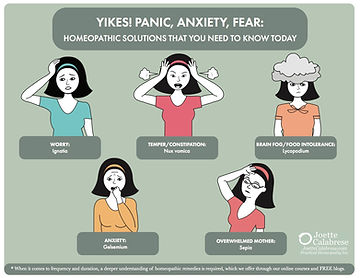
Homeopathy Infographic for Panic, Anxiety, Fear
27. Homeopathic Remedies: Homeopathy is life saving, mind saving, body saving, spirit saving… you name it! During acute emotional episodes involving fear or anxiety attacks, fear of death or dying, we utilize aconite and Bach Rescue Remedies (it also comes as pastilles and creams) or Mimulus Flower Essence. We also use the best indicated flower essence based on emotional symptoms or needs.
What is best however is to give your child’s constitutional remedy if you know it. A constitutional remedy is a lifetime ally that supports the child’s entire being (mental, emotional and physical) and helps during acute episodes of illness or emotional upset as well as for chronic conditions. Reach out if you’d like to find out your child’s constitutional remedy.
28. Kid’s Adrenal Cocktail: A kid’s adrenal cocktail is NOT the adult adrenal cocktail of unrefined salt + cream of tarter with some orange juice. A kid’s adrenal cocktail is basically any kind of magnesium rich drink or bath, for us it’s usually Hot Cacao, Oatstraw Tea or I give them a Epsom Salt bath referred to in #25. We also sparingly use Natural Vitality Calm, as it will cause diarrhea if over-used.
Please reach out for more information on how we can help you and your kids better cope with the stresses of your life.

